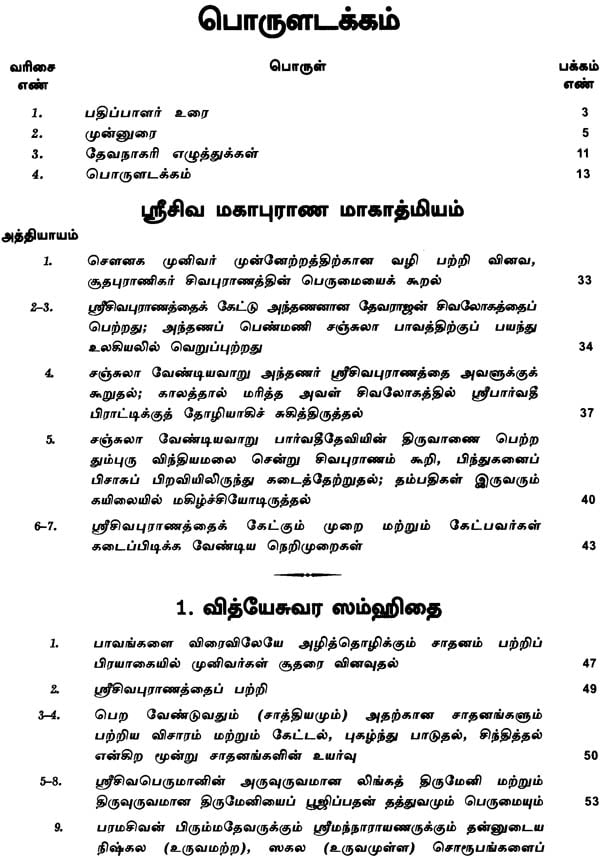Shiva Maha Puranam In Tamil Pdf Stories
суббота 05 января admin 5
The Puranas are of two kinds: the Mahapuranas and the Upapuranas. Each class consists of eighteen puranas, bringing the total number of puranas to thirty-six.
Having read the stories of Lord shiva, don't you want to read the stories of Lord shiva's devotees. Read through the Life of nAyanmAr and Other Devotees. Plays of God - thiruviLaiyADal purANam.
The Mahapuranas or “Great Puranas” are the more important ones, while the Upapuranas or “sub-puranas” are the minor ones are often neglected in study. The Shiv Puran The Shiv Puran of course praises the glory and greatness of Shiva, describes the ritual and philosophical principles of Shiva worship, embodies descriptions, sermons and dissertations on the greatness of his divinity, recounts his emblems, attributes, exploits and incarnations, narrates legends and dwells upon the merit of installing and consecrating the linga.
The Shiv Puran as we have it today is said to be only a fragment of what originally existed. This is a common theme in all Indian mythology, an alludes to the impossibility of encompassing knowledge of all creation within a book, or any number of books for that matter. The Shiv Puran is today a matter of interest for many physicist-philosophers, since many of the stories bear an uncanny resemblance to the descriptions given by modern cosmology regarding the creation and birth of the universe. Fritjof Capra for instance, narrates in his book “The Tao of Physics”, how similar in structure the statue of Nataraja (Shiva as the Lord of Dance) is to the traces left behind by subatomic particles in a Bubble Chamber. Several stories in the purana deal with how Shiva creates the universe. In one such for example, it is said that there is one Shiva and Parvati pair looking after one universe, and there are many such pairs in creation.
This is quite similar to the many-worlds hypothesis being put forward by some quantum physicists today. The text of the Shiv Puran as it exists today is arranged into seven Samhitas: Vidyavara, Rudra, Satarudra, Kotirudra, Uma, Kailasa and Vayaviya. The Rudrasamhhita itself is divided into five sections: Creation, the story of Sati, the story of Parvati, the birth and adventures of Kumara and Shiva’s battles.  The Vayaviya has two parts, the Purvabhaga and Uttarabhaga. It is called Vayaviya, because although it is Suta who narrates it in the Naimisha forest, it was originally narrated by Vayu.
The Vayaviya has two parts, the Purvabhaga and Uttarabhaga. It is called Vayaviya, because although it is Suta who narrates it in the Naimisha forest, it was originally narrated by Vayu.
As per Vayaviya, the original Shiv Puran had twelve Samhitas as against the current seven. The five additional ones were Vainayaka, Matr, Rudraikadasa, Sahasrakoti and Dharma.
All twelve Samhitas together comprised one hundred thousand Slokas. The five Samhias have been dropped however over the course of time and the Shiva Purana we have with us today consists of twenty-four thousand slokas, said to have been abridged by Sage Vyasa. Most Puranic scholars agree upon the authenticity of the seventeen Mahapuranas other than the Shiv Puran.
Generally the eighteenth is listed as the Shiva Purana, though a few list the Vayu Purana in its place. JL Shastri conjectures the following. “We know that Sivapurana is divided into seven Samhitas, one of which is the Vayaviya.

We have the testimony of Sivapurana itself that the original Sivapurana consisting of one hundred thousand slokas was abridged into twentyfour thousand slokas. On the strength of this evidence it cannot be unreasonable to suppose that there was a proto-Sivapurana and a proto-Vayaviya. It is not unlikely that there was a close affinity between the extant Vayupurana and the proto-Vayaviya or that the extant Vayupurana is a recension of the proto-Vayaviya and thus a part of Sivapurana itself. Solution lies in assuming identicality of the two on the basis of this suggestion, not in accepting the one and rejecting the other.”.
• • • The Shiva Purana is one of the eighteen genre of texts in, and part of the literature corpus. It primarily centers around the Hindu god and goddess, but references and reveres all gods. The Shiva Purana asserts that it once consisted of 100,000 verses set out in twelve (books), however the Purana adds that it was abridged by sage Vyasa before being taught to Romaharshana. The surviving manuscripts exist in many different versions and content, with one major version with seven books (traced to South India), another with six books, while the third version traced to the medieval region of the with no books but two large sections called Purva-khanda (previous section) and Uttara-khanda (later section).
The two versions that include books, title some of the books same and others differently. The Shiva Purana, like other Puranas in Hindu literature, was likely a living text, which was routinely edited, recast and revised over a long period of time. The oldest manuscript of surviving texts was likely composed, estimates, around 10th- to 11th-century CE. Some chapters of currently surviving Shiva Purana manuscripts were likely composed after the 14th-century. The Shiva Purana contains chapters with Shiva-centered,, relationship between gods, ethics,, Tirtha (pilgrimage) sites, bhakti, rivers and geography, and other topics.
